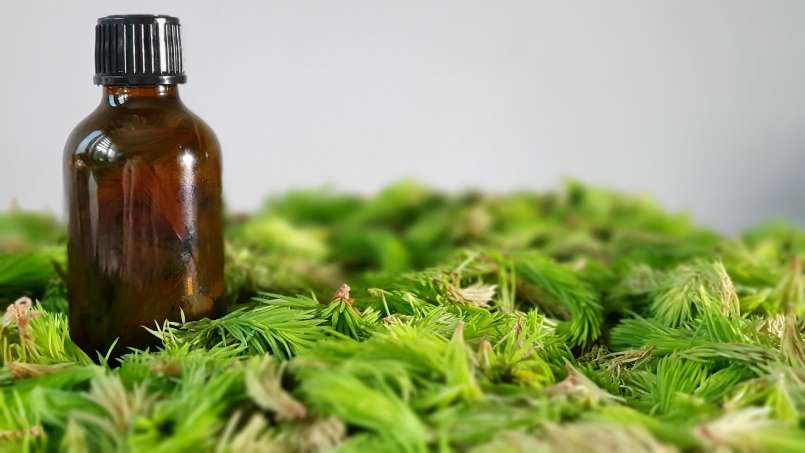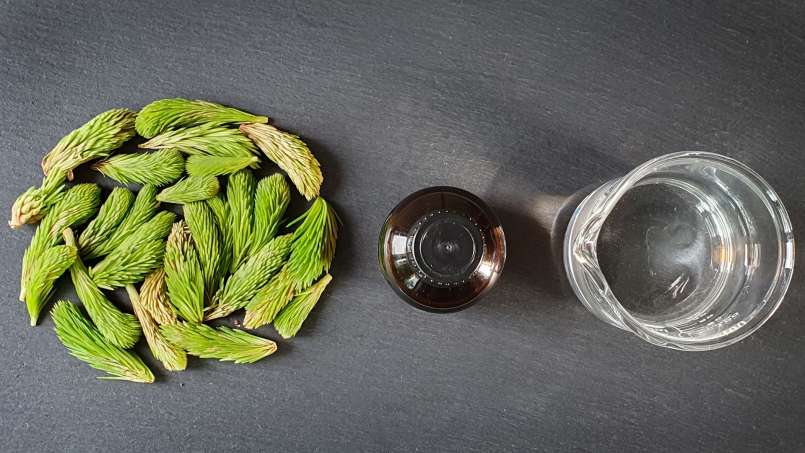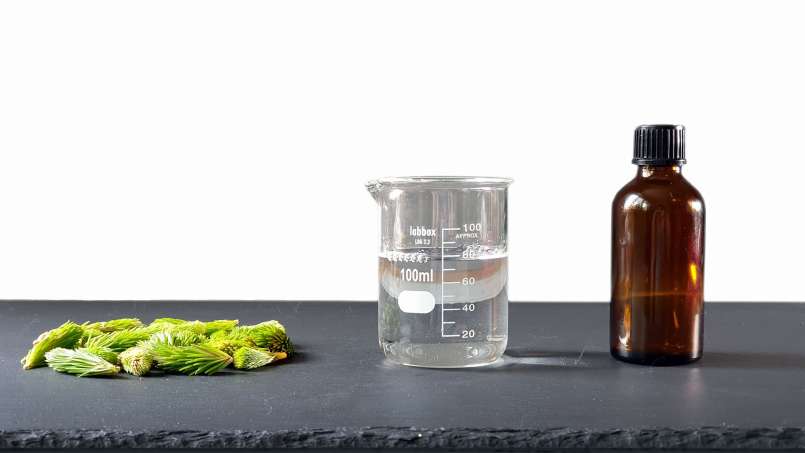Pine buds tincture
Pine buds have been known since ancient times for their benefits to the body. In the form of tincture can be used both internally and externally, with extraordinary therapeutic power.
Servings: 5 servings
50 ml of tincture of pine buds ~ 5 servings
Ingredients
Materials
- - recommended dark glass container
- - sieve
Preparation
 Pine buds are washed and cleaned of any impurities, then dried with a kitchen towel.
Pine buds are washed and cleaned of any impurities, then dried with a kitchen towel.- Pine buds can be finely crushed for better maceration with alcohol or can be used as such when they are small and fresh. If they are crushed and if a harder refined double alcohol (> 90 degrees) is used, the maceration time is shorter ~ 10 days.
I chose to use whole buds.  Pine buds can be finely crushed for better maceration with alcohol or can be used as such when they are small and fresh. If they are crushed and if a harder refined double alcohol (> 90 degrees) is used, the maceration time is shorter ~ 10 days.
Pine buds can be finely crushed for better maceration with alcohol or can be used as such when they are small and fresh. If they are crushed and if a harder refined double alcohol (> 90 degrees) is used, the maceration time is shorter ~ 10 days.
I chose to use whole buds. Add the alcohol until the container is completely filled.
Add the alcohol until the container is completely filled. Close the container and leave to macerate in a dark and cool place for about 30 days. The maceration time differs depending on the quality of the buds, whether they were crushed or one, by the strength (concentration) of the alcohol. The minimum maceration time is 10 days.
Close the container and leave to macerate in a dark and cool place for about 30 days. The maceration time differs depending on the quality of the buds, whether they were crushed or one, by the strength (concentration) of the alcohol. The minimum maceration time is 10 days.
I chose an alcohol of ~ 60 degrees and I used whole fresh buds, so I left it to macerate for 30 days.- After the maceration period, the liquid is separated with the help of a sieve. This gives pine bud tincture . It is kept in glass containers, preferably dark in color, in cool places and away from light.
The macerated buds, after being squeezed well, are discarded.
Administration
You can also try the administration of the tincture on a dry bread cube (~ 0.5 cm) or on a sugar cube (beware of those with sugar restrictions).
Observations
External use: neurosis, cardiac neurosis, scabies, wound healing, comforting good, irritated and red skin.
Wounds heal much faster and do not become infected if, after being thoroughly cleaned, they are anointed with pine bud tincture.
❗ In this recipe we used ingredients in much too small quantities to be filmed more easily. We recommend making the recipe with ingredients for at least 250ml of tincture.
Effects and benefits
- ✔ antiseptics
- ✔ antibiotics
- ✔ soothing
- ✔ contributes to the relief of respiratory diseases: acute and chronic bronchitis, pneumonia, cough, bronchial asthma and tuberculosis
- ✔ anti-inflammatory
- ✔ anti-infective
- ✔ healing
- ✔ strengthens the osteo-articular system
- ✔ stimulates bone and cartilage tissue
- ✔ has a remineralized effect, favors the consolidation of fractures
- ✔ improves joint mobility
- ✔ reduces appetite
- ✔ expectorant
- ✔ emollient in acute respiratory infections
- ✔ adjuvant in: -respiratory diseases, cough, cold, asthma, allergies, flu, tonsillitis, tracheitis, laryngitis, pharyngitis
Contraindications
- For people with stomach problems, possibly try the administration option on a cube of dry bread or sugar.
- It's alcohol, so not suitable for pregnant women
Treats:
✔ Cough and bronchitis: gargle with 2 teaspoons of pine bud tincture.✔ Migraines, dizziness, vertigo : gargle with 2 teaspoons in a quarter glass with water or massage the temples
✔ Vomiting : temple massage with tincture
✔ Gastroenteritis, vomiting and other digestive disorders : bread soaked in a teaspoon of pine bud tincture on an empty stomach, 3-4 times / day for 10 days
✔ Cystitis, urinary microlithiasis, nephritis : it is treated with the tincture of pine buds, from which one teaspoon diluted in a glass of water is taken, 3-4 times a day. A cure lasts 10 days, and can be resumed as many times as needed. People who have kidneys sensitive to sudden colds or who are prone to cystitis should prepare this tincture in advance.
✔ Neuralgia : take 4-5 teaspoons of undiluted pine syrup on an empty stomach. In addition, apply a compress of pine bud tincture to the affected area, which lasts for a quarter of an hour. If neuralgia occurs as a result of sensitivity to cold, hold a bottle of hot water over the compression.
FAQ 💡❓
How quickly do the effects appear after administration?
➡️ The first effects can be felt after a few days, especially in acute respiratory diseases, but for chronic diseases, sustained administration for 2-4 weeks is necessary.
Is pine bud tincture effective in recurrent urinary tract infections?
➡️ Yes, it has diuretic and anti-infective properties, being effective in chronic cystitis or repeated episodes of urinary tract infections.
Can it be combined with other natural remedies for immunity?
➡️ Yes, pine bud tincture works very well in combination with echinacea, propolis or garlic tincture, for a synergistic effect on immunity.
How does it act on the nervous system?
➡️ It has a slight calming and toning effect, being useful in case of mental fatigue, neurosis or irritability.
What effect does it have on smokers?
➡️ It helps regenerate the respiratory mucosa affected by smoking and reduces the discomfort caused by dry or productive cough.
Can it be administered in parallel with allopathic treatment?
➡️ In most cases, yes, but medical consultation is recommended to avoid interactions, especially if you are undergoing treatment with anticoagulants or for gastric disorders.
Does the tincture have an antibacterial effect?
➡️ Yes, pine buds contain volatile compounds with antibacterial action, being effective against respiratory and urinary pathogens.
What does “cold maceration” mean and why is it important?
➡️ Cold maceration keeps volatile oils and heat-sensitive phytonutrients intact, maintaining the maximum efficiency of the plant.
What happens if I exceed the recommended dose?
➡️ Excessive diuretic effects, mild gastric irritation or agitation may occur; compliance with the dose is important for efficiency and safety.
Is it suitable for detoxifying the body?
➡️ Yes, it has a purifying and diuretic effect, supporting the elimination of toxins through the kidneys and respiratory tract.
Is it safe for daily, long-term use?
➡️ Yes, in 2-3 week courses with breaks in between. For longer continuous administration, monitoring or consultation with a phytotherapist is recommended.
Can it be applied locally to the skin?
➡️ Yes, it has an antiseptic and healing effect, being useful in treating wounds, irritations and mild dermatological conditions.
Does the alcohol content affect the effectiveness of the plant?
➡️ On the contrary, alcohol extracts the active substances from the plant, enhancing the effect and ensuring long-term preservation.
What is the difference between pine bud tincture and pine bud syrup?
➡️ The tincture is much more concentrated and penetrates the body faster, while the syrup is milder and can be administered to children (in some cases).
Can I use dried pine buds instead of fresh ones?
➡️ Dried buds can also be used, but the effectiveness of the tincture will be slightly reduced – fresh ones retain the essential volatile oils better.






Comments